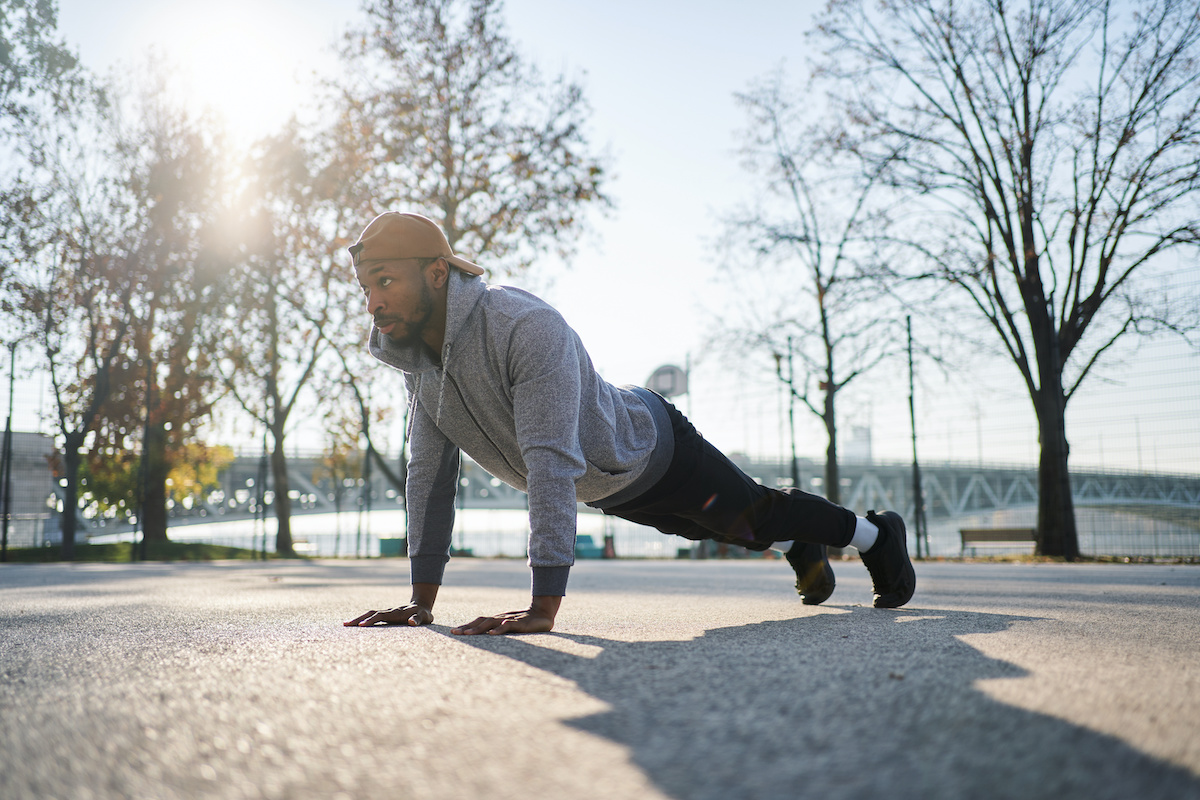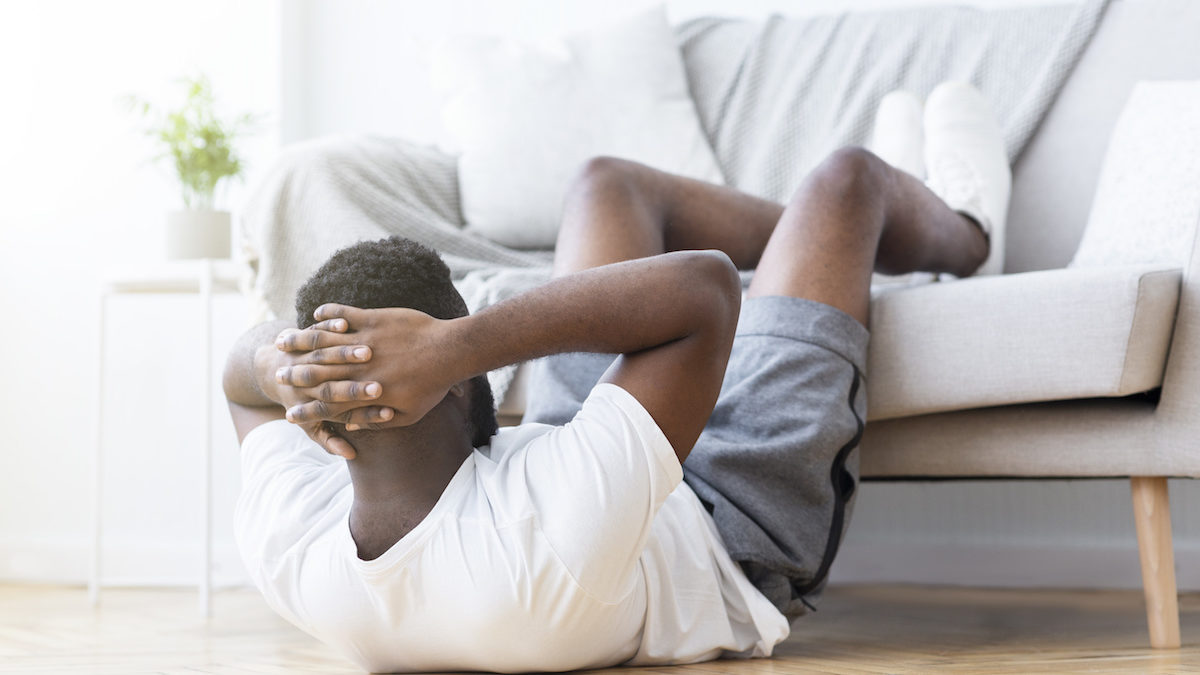The Abs Workout You Can Do Absolutely Anywhere

Working out at home ain’t easy, especially if you’re a gym bunny used to throwing monster dumbbells around the sweaty weights room, or squatting up a storm on the racks. But training your abs is one of the easiest workouts to do at home, or anywhere for that matter. As long as you have a 2 x 2 metre space you should be able to work your core to your hearts content (or until your mid-riff has had enough and needs to tap out).
So whether you’re working from home, on your travels, or in-between gym memberships, here’s personal trainer James Pisano with everything you need to know about the home workout staple, along with an abs workout to perfect when you can stomach that next trip to the gym.
Why Should You Do An Abs Workout?
Sure, poppin’ abs are great for the Insta likes, but besides looking as chiselled as Tyler Durden, a strong core can also benefit you in many other areas.
“For me, by far the largest benefit of having great abs is the low body fat count,” says Pisano. “We know higher counts of body fat attribute to so many health issues. They don’t need to be “popping” but visible lines are a good sign of a balanced body.”
And this balance can be felt as you work out other parts of your body.
Interestingly, a study published in the European Journal of Applied Physiology found that after your shoulders, the lateral sides of your abs are the next muscle to engage during lifting exercises.
The extremities of your body (i.e. the arms and legs) also rely on your core for stabilisation, and producing force in the movement. If your core isn’t providing the foundation that you need, then your ability to produce enough force to lift heavier weights will be diminished, stalling those gains while also putting you at great risk of injury (particularly in the lower back).
Your core acts as a protective shield for your spine you see, and the internal organs within, assisting in circulation and creating a safe building block for all movement. Put simply, a six-pack is not just a pretty face; it’s the key to unlocking a stronger body all round.

What Do You Have To Do To Get Great Abs?
The difference between a core workout and an abs workout is really down to semantics. The former refers to the practical whereas the latter is more concerned with the aesthetic – the six-pack you see on front covers, gleaming in a mist of faux sweat. If you’re chasing the latter, then what you eat is going to have as much of an impact as your abs workout schedule.
“Nutrition is the largest benefactor towards having exposed abdominal muscles,” explains Pisano. “Your working out only tackles around 20 percent of the process, as a calorie deficit is almost always necessary to achieve this goal.
“But metabolically we see through research that 40 percent of daily food is held back for ‘activity’ by the body naturally. So we do need to use this energy to expose those abs, It’s a package deal. Nutrients also fulfil the body’s needs to safely adapt, as without them our hormones go off track and you will find it harder to make physical changes as your body will be dealing with other things.”
The Abs Home Workouts
A six pack that’ll also help you build a more muscular body is an easy sell.
Less easy, are these two killer abs workouts Pisano has put together. Neither needs any equipment (an exercise mat might help prevent friction and potential injuries though) and both are ideal for working out at home.
The first is a superset, which requires you to move move quickly between exercises with just a 10 second breather in-between.
Challenging The Abs Workout
Open Planks, (Or Plank Walkouts)
How Many Reps? 30 seconds work, with 10 seconds rest before you move on to the next exercise.
Technique: Get into the plank position on the floor with your elbows down. Keep your body straight from top to bottom and your feet shoulder width apart. Squeezing the bum and tummy, and slowly move your arms a little forward from under your shoulders and hold. If strong enough, move forward again a little more and hold.
Top Tip: Don’t challenge the body for any more than 30 seconds at a time with these. They’re tough.
Alternating V Crunches
How Many Reps? Once again, 30 seconds work, with 10 seconds rest before you move onto the next exercise.
Technique: Laying flat on your back, arms and legs extended out straight. Lift one leg up off the floor, keeping the other leg straight. Reach up and over with the opposite hand, crunching the tummy as your ascend. Slowly descend and switch sides.
Top Tip: Keep your non-lifting leg hovered above the ground to make the exercise harder. Alternatively, beginners might find it easier if they keep the leg touched to the ground.
Russian Trunk Rotations
How Many Reps? You know the drill. 30 seconds work, with 10 seconds rest. When you’re finished with this one, go back to the open planks, repeating the mini-circuit three times over.
Technique: Start by sitting on the floor. Keeping the back straight, lean back around 45 degrees, with a slight bend in the knees. Arms out straight in front of the chest. Now rotate the torso turning right (90 degrees max) then return to the centre and repeat on the same side each time. Do both sides separately.
Top Tip: Make sure you are squeezing in the tummy to keep that lower back safe at all times.
Exposing The Abs
As opposed to jumping from one exercise to the other as in the previous workout, this abs workout allows you to have a breather in between. All three will also make for good combinations with other body part workouts (so a 40 minute jog paired with an upper body home workout for example), and less obviously target the core, without being any less effective.
Mountain Climbers
Reps: 60 seconds for 4 rounds with a full recovery in between.
Technique: Plank position to start (on hands is best). Now, squeezing the tummy pull one knee up and into the chest, twisting as you pull and aiming for the opposite elbow. switching over at each repetition.
Top Tip: You can do mountain climbers quickly or slowly, but opting for the former will get your heart pumping, making the move an excellent addition to a HIIT workout.
Long distance Jogging Or Interval Sprints
Reps: Over 30 minutes if jogging. As many as possible if interval sprinting.
Top Tip: “I don’t recommend running generally as there are many variables that need to be checked before hand,” notes Pisano. “But if you have the ability to jog for 30-40 minutes or sprint intensely through intervals (as many as possible) then both can metabolically attack fat stores very well.”
Reverse Lunges
Reps: 18 lunges alternating with each leg, times by four rounds.
Technique: From a standing position step back with one foot and as your toes hit the floor bend both knees – sitting back and down (avoid touching the ground). Keep your hands off your legs.
Now, squeeze your bum and front thigh, pulling you forward and up. Keep squeezing the bum and switch legs, stepping back with the other. do not rush down (or up) as you need to control the movement. Count 3 seconds on each rep.
Top Tip: While the lunge is historically more of a lower body exercise, you core is having to work overtime here to keep you stable, making the reverse lunge a two-for-one deal you can’t afford to miss.
Exercises To Add To Your Abs Workout In The Gym
Cable Push Out
Reps: 12 repetitions each side for three sets.
Technique: Load up the cable machine to a small but challenging weight, take the single hand grip and turn so the machine is at your side. Step out and away from the machine, holding the handle to your chest. Now, squeeze your tummy and lock the hips while keeping everything facing forward.
Push the handle away from your body. As the arms extend the core will engage to protect the spine. Keep the hands up, moving forward and your arms straight. Slowly retract and go again. One side at a time.
Goblet Squat
Reps: 12 repetitions each side for three sets.
Technique: Front load a heavy (for you) kettlebell and turn it upside down so the handle is faced down. Hold the ball of the bell with your hands cupping from underneath, elbows under the hands. Try and keep the kettlebell off the body the entire time (just slightly). Feet wider than shoulders, heels in at an angle with your toes and knees pointing out in the same direction.
Open your hips, push the knees out and pull your bum down, sitting back into the squat. Squeeze everything and drive your hips up – back to standing. 3 seconds minimum on each repetition
Top Tip: Keep the kettlebell close to the chest to maintain a safe centre of gravity and protect the spine.

























